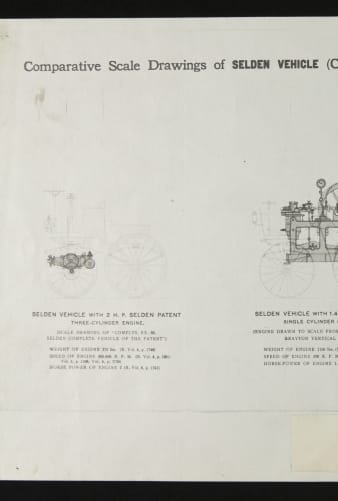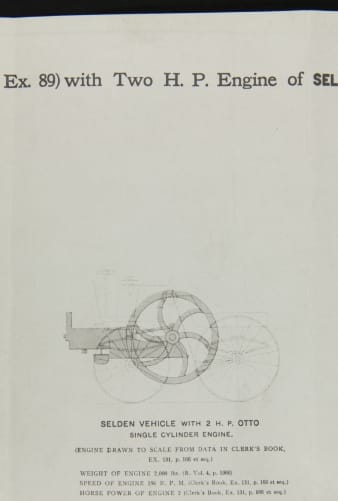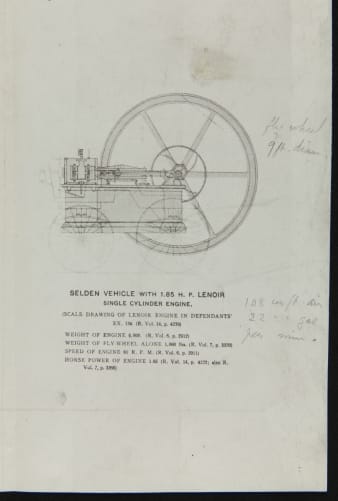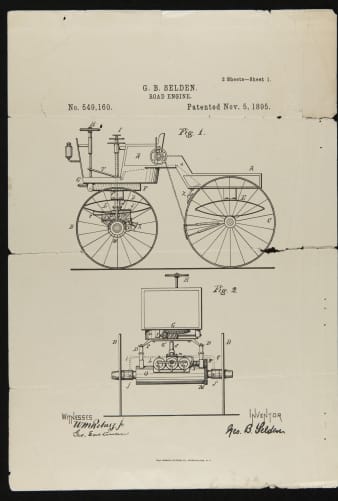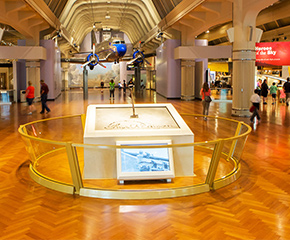
Selden Patent Lawsuit Collection
The Selden Patent Lawsuit Collection contains documents, correspondence, and financial reports relating to George B. Selden's patent for road vehicles and the Electric Vehicle Company v. Ford lawsuit.
Biographical / Historical Note
George Baldwin Selden was born on September 14, 1848 in Clarkston, New York, the son of a well-to-do local lawyer. He attended local public schools, the University of Rochester, and graduated from Yale University after a brief enlistment in the Union...
MoreGeorge Baldwin Selden was born on September 14, 1848 in Clarkston, New York, the son of a well-to-do local lawyer. He attended local public schools, the University of Rochester, and graduated from Yale University after a brief enlistment in the Union Army during the Civil War. He was admitted to the New York bar in 1871 and joined his father's law firm. Selden turned his attention to mechanical design and in 1879 he filed a patent application for a self-propelled "road engine." In 1895 he was granted a final patent. The most unique feature of his patent was its effort to cover all self-propelled wheeled vehicles built in the United States in 1879. Selden was never able to manufacture automobiles himself and in 1899, the Columbia and Electric Vehicle Company, later called the Electric Vehicle Company, in New Haven, Connecticut, purchased the patent rights from Selden for cash and future royalty payments.
By 1903, several automobile manufacturers, including some of the successful early companies such as the Winton Motor Carriage Company, Olds Motor Works, and Packard Motor Car Company, recognized the validity of Selden's patent and agreed to pay the Electric Vehicle Company a royalty of 1.25% for each vehicle manufactured with proceeds distributed to Selden, the Electric Vehicle Company, and eventually a national association of automobile manufacturers. Also in 1903, the royalty paying companies established the Association of Licensed Automobile Manufacturers (ALAM) in conjunction with the Electric Vehicle Company in an effort to control automotive competition and issued licenses to new companies.
In 1903, Henry Ford applied to the ALAM for a license but was turned down by the selection committee primarily because it was believed that Ford Motor Company was an assembly company rather than a manufacturing company. Henry Ford decided to fight the patent and continued to produce vehicles. Ford was then sued by the ALAM, George B. Selden, and the Electric Vehicle Company for patent infringement. Ford appealed a 1909 decision upholding Selden's patent and in 1911 a federal appellate court decided in favor of Henry Ford and effectively ended Selden's legal claim to a patent covering all motor vehicles. After Selden's death in 1922, the ALAM reorganized as a national advocacy group for automobile manufacturers and endured through several name changes including the National Automobile Chamber of Commerce, and the Automobile Manufacturer's Association.
LessScope and Content Note
The Selden Patent Lawsuit collection consists of two series, Subject Files and Lantern Slides. Materials in these two series were obtained from separate sources and combined by staff of The Henry Ford into a single assembled collection.
The...
MoreThe Selden Patent Lawsuit collection consists of two series, Subject Files and Lantern Slides. Materials in these two series were obtained from separate sources and combined by staff of The Henry Ford into a single assembled collection.
The Subject Files series, 1891-1955 (2.0 cubic ft.), includes correspondence, clippings, British, French, and American patent copies and financial reports. Researchers should note that material in this collection was gathered from various sources and includes a wide variety of general information about the early automobile industry. Of special interest are the annual reports, audits, national automobile show planning and cost reports, royalty summaries, and other financial records of automobile manufacturer's organizations such as the Association of Licensed Automobile Manufacturers and a whollyowned holding company, the Association Patents Company, the National Automobile Chamber of Commerce, the Automobile Board of Trade, and the Automobile Manufacturer's Association.
The Lantern Slides series, circa 1904-1909 (0.2 cubic ft.), consists of 56 glass lantern slides. As a co-plaintiff in the infringement lawsuit filed against Henry Ford and Ford Motor Company, Selden's attorneys used the lantern slides to illustrate early automobile development and the part George B. Selden played in that process. The slides also illustrate engine and motor vehicle development in Europe and the United States at the turn of the century.
LessCollection Details
Object ID: 86.1.1704.0
Creator: Henry Ford (Organization). Benson Ford Research Center
Inclusive Dates: 1898-1955
Bulk Dates: 1900-1925
Size: 2.2 cubic ft. (5 boxes)
Language: English
Collection Access & Use
Item Location: Benson Ford Research Center
Access Restrictions: The collection is open for research.
Credit: From the Collections of The Henry Ford.
Digitized Artifacts From This Collection
In many cases, not all artifacts have been digitized.
Contact us for more information about this collection.
Driving the Selden Motor Buggy during the Selden Patent Suit
Artifact
Lantern slide
Summary
George Selden conceived -- but didn't build -- a self-propelled gasoline-powered vehicle in 1877 and patented the idea in 1895. The Association of Licensed Automobile Manufacturers enforced Selden's patent, but Henry Ford fought ALAM in court. This car was built in 1907 as evidence for the legal battle. Ford ultimately won, freeing himself and other automakers from paying royalties to ALAM.
Creators
Keywords
Object ID
86.186.2
Credit
From the Collections of The Henry Ford.
Location
By Request in the Benson Ford Research Center
Related Objects
Get more details in Digital Collections at:
Driving the Selden Motor Buggy during the Selden Patent Suit
What is The Henry Ford?
The national attraction for discovering your ingenuity while exploring America’s spirit of innovation. There is always much to see and do at The Henry Ford.
George Selden with the 1907 Selden Motor Buggy during the Selden Patent Suit
Artifact
Lantern slide
Summary
George Selden conceived -- but didn't build -- a self-propelled gasoline-powered vehicle in 1877 and patented the idea in 1895. The Association of Licensed Automobile Manufacturers enforced Selden's patent, but Henry Ford fought ALAM in court. This car was built in 1907 as evidence for the legal battle. Ford ultimately won, freeing himself and other automakers from paying royalties to ALAM.
Creators
Keywords
Object ID
86.186.3
Credit
From the Collections of The Henry Ford.
Location
By Request in the Benson Ford Research Center
Related Objects
Get more details in Digital Collections at:
George Selden with the 1907 Selden Motor Buggy during the Selden Patent Suit
What is The Henry Ford?
The national attraction for discovering your ingenuity while exploring America’s spirit of innovation. There is always much to see and do at The Henry Ford.
"What is the Selden Patent on Gasoline Automobiles?," 1910
Artifact
Brochure
Date Made
12 April 1910
Summary
The Association of Licensed Automobile Manufacturers believed that George Selden's 1895 patent covered any and all internal combustion automobiles. When Henry Ford refused to pay ALAM's requested royalties, the organization took him to court. After a lengthy legal battle, the U.S. Court of Appeals found in Ford's favor in 1911. Automakers were freed from patent fees and Ford became a folk hero.
Place of Creation
Object ID
86.185.114
Credit
From the Collections of The Henry Ford. Gift of Henry Austin Clark, Jr.
Location
By Request in the Benson Ford Research Center
Get more details in Digital Collections at:
"What is the Selden Patent on Gasoline Automobiles?," 1910
What is The Henry Ford?
The national attraction for discovering your ingenuity while exploring America’s spirit of innovation. There is always much to see and do at The Henry Ford.
"Selden Patent Overthrown by Federal Court," 1911
Artifact
Clipping (Information artifact)
Date Made
10 January 1911
Summary
The Association of Licensed Automobile Manufacturers believed that George Selden's 1895 patent covered any and all internal combustion automobiles. When Henry Ford refused to pay ALAM's requested royalties, the organization took him to court. After a lengthy legal battle, the U.S. Court of Appeals found in Ford's favor in 1911. Automakers were freed from patent fees and Ford became a folk hero.
Creators
Place of Creation
Object ID
86.185.112
Credit
From the Collections of The Henry Ford. Gift of Henry Austin Clark, Jr.
Location
By Request in the Benson Ford Research Center
Get more details in Digital Collections at:
"Selden Patent Overthrown by Federal Court," 1911
What is The Henry Ford?
The national attraction for discovering your ingenuity while exploring America’s spirit of innovation. There is always much to see and do at The Henry Ford.
"Selden Loses Decision in Circuit Court of Appeals," 1911
Artifact
Clipping (Information artifact)
Date Made
09 January 1911
Summary
The Association of Licensed Automobile Manufacturers believed that George Selden's 1895 patent covered any and all internal combustion automobiles. When Henry Ford refused to pay ALAM's requested royalties, the organization took him to court. After a lengthy legal battle, the U.S. Court of Appeals found in Ford's favor in 1911. Automakers were freed from patent fees and Ford became a folk hero.
Creators
Object ID
86.185.113
Credit
From the Collections of The Henry Ford. Gift of Henry Austin Clark, Jr.
Location
By Request in the Benson Ford Research Center
Get more details in Digital Collections at:
"Selden Loses Decision in Circuit Court of Appeals," 1911
What is The Henry Ford?
The national attraction for discovering your ingenuity while exploring America’s spirit of innovation. There is always much to see and do at The Henry Ford.
"Comparative Scale Drawings of Selden Vehicle, Complainants' Ex. 89," circa 1905
Artifact
Print (Visual work)
Date Made
circa 1905
Summary
George Selden conceived -- but didn't build -- a vehicle powered by a two-stroke gasoline engine in 1877, and he received a patent in 1895. The Association of Licensed Automobile Manufacturers enforced Selden's patent, but Henry Ford successfully fought ALAM in court. These drawings, prepared for the suit, compared Selden's proposed vehicle with various engines available in the mid-1870s.
Creators
Keywords
Object ID
86.185.115
Credit
From the Collections of The Henry Ford. Gift of Henry Austin Clark, Jr.
Location
By Request in the Benson Ford Research Center
Get more details in Digital Collections at:
"Comparative Scale Drawings of Selden Vehicle, Complainants' Ex. 89," circa 1905
What is The Henry Ford?
The national attraction for discovering your ingenuity while exploring America’s spirit of innovation. There is always much to see and do at The Henry Ford.
Selden Road-Engine Specifications, U. S. Patent Number 549,160, November 5, 1895
Artifact
Patent
Date Made
1895
Summary
George Selden conceived -- but didn't build -- a gasoline-powered self-propelled vehicle in 1877. Selden, a patent attorney, shrewdly waited until 1895 to receive a patent on the idea -- long enough for the automobile industry to emerge and his patent to become valuable. After an eight-year legal fight led by Henry Ford, Selden's broad patent claim was severely restricted in 1911.
Creators
Place of Creation
Object ID
86.185.116
Credit
From the Collections of The Henry Ford. Gift of Henry Austin Clark, Jr.
Location
By Request in the Benson Ford Research Center
Get more details in Digital Collections at:
Selden Road-Engine Specifications, U. S. Patent Number 549,160, November 5, 1895
What is The Henry Ford?
The national attraction for discovering your ingenuity while exploring America’s spirit of innovation. There is always much to see and do at The Henry Ford.


George Selden and Henry Selden with the 1907 Selden Motor Buggy during the Selden Patent Suit
 Details
Details
George Selden and Henry Selden with the 1907 Selden Motor Buggy during the Selden Patent Suit
Artifact
Lantern slide
Summary
George Selden conceived -- but didn't build -- a self-propelled gasoline-powered vehicle in 1877 and patented the idea in 1895. The Association of Licensed Automobile Manufacturers enforced Selden's patent, but Henry Ford fought ALAM in court. This car was built in 1907 as evidence for the legal battle. Ford ultimately won, freeing himself and other automakers from paying royalties to ALAM.
Creators
Object ID
86.186.1
Credit
From the Collections of The Henry Ford.
Location
By Request in the Benson Ford Research Center
Related Objects
Get more details in Digital Collections at:
George Selden and Henry Selden with the 1907 Selden Motor Buggy during the Selden Patent Suit
What is The Henry Ford?
The national attraction for discovering your ingenuity while exploring America’s spirit of innovation. There is always much to see and do at The Henry Ford.




















